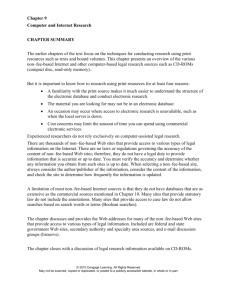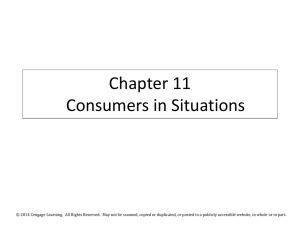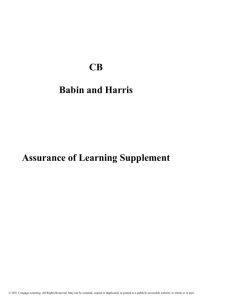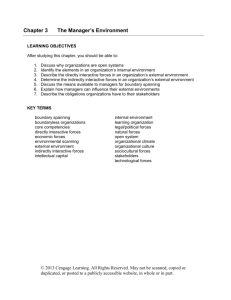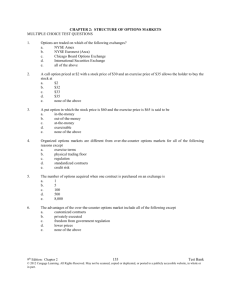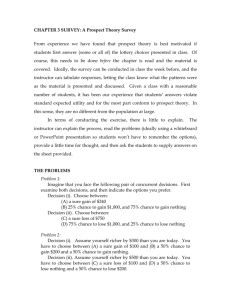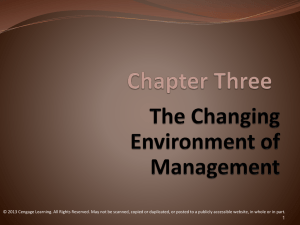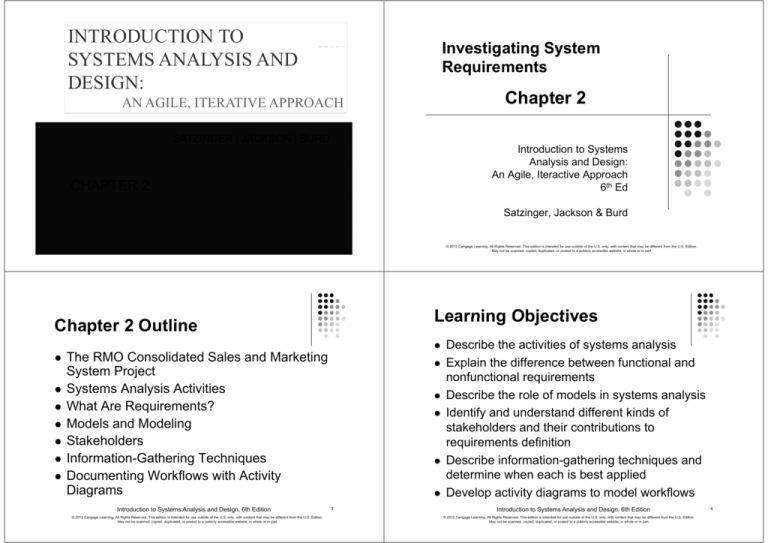
INTRODUCTION TO
SYSTEMS ANALYSIS AND
DESIGN:
DESIGN
Investigating System
Requirements
Chapter
p
2
AN AGILE, ITERATIVE APPROACH
SATZINGER | JACKSON | BURD
Introduction to Systems
Analysis and Design:
An Agile, Iteractive Approach
6th Ed
CHAPTER
Chapter 22
Satzinger, Jackson & Burd
Systems Analysis and Design in a Changing World, 6th Edition
1
© 2012 Cengage Learning. All Rights Reserved. This edition is intended for use outside of the U.S. only, with content that may be different from the U.S. Edition.
May not be scanned, copied, duplicated, or posted to a publicly accessible website, in whole or in part.
Learning Objectives
Chapter 2 Outline
The RMO Consolidated Sales and Marketing
System
y
Project
j
Systems Analysis Activities
What Are Requirements?
Models and Modeling
St k h ld
Stakeholders
Information-Gathering Techniques
Documenting Workflows with Activity
Diagrams
g
Introduction to Systems Analysis and Design, 6th Edition
© 2012 Cengage Learning. All Rights Reserved. This edition is intended for use outside of the U.S. only, with content that may be different from the U.S. Edition.
May not be scanned, copied, duplicated, or posted to a publicly accessible website, in whole or in part.
3
Describe the activities of systems analysis
Explain the difference between functional and
nonfunctional requirements
Describe the role of models in systems analysis
Identify and understand different kinds of
stakeholders and their contributions to
requirements definition
Describe information-gathering
g
g techniques
q
and
determine when each is best applied
Develop activity diagrams to model workflows
Introduction to Systems Analysis and Design, 6th Edition
© 2012 Cengage Learning. All Rights Reserved. This edition is intended for use outside of the U.S. only, with content that may be different from the U.S. Edition.
May not be scanned, copied, duplicated, or posted to a publicly accessible website, in whole or in part.
4
Ridgeline Mountain Outfitters
(RMO)
Overview
Chapter 1 introduced the system development lifecycle
(SDLC) and demonstrated its use for a small project
This chapter expands the SDLC processes to cover a
wider range of concepts, tools and techniques
C
Core
process 3
3: Discover
Di
and
d understand
d t d th
the d
details
t il off
the problem or need—is the main focus of systems
analysis
y
Systems analysis activities are detailed in this chapter
Introduction to Systems Analysis and Design, 6th Edition
5
Introduction to Systems Analysis and Design, 6th Edition
Ridgeline Mountain Outfitters
(RMO)
Information Systems Strategic
Plan
Strategic planning and competitive advantage
for organizations involves leveraging information
systems
The information systems strategic plan is
based on the overall strategic needs of the
organization
The information
f
systems strategic plan includes
definition of the technology architecture and
the application architecture needed by the
organization
Introduction to Systems Analysis and Design, 6th Edition
© 2012 Cengage Learning. All Rights Reserved. This edition is intended for use outside of the U.S. only, with content that may be different from the U.S. Edition.
May not be scanned, copied, duplicated, or posted to a publicly accessible website, in whole or in part.
6
© 2012 Cengage Learning. All Rights Reserved. This edition is intended for use outside of the U.S. only, with content that may be different from the U.S. Edition.
May not be scanned, copied, duplicated, or posted to a publicly accessible website, in whole or in part.
© 2012 Cengage Learning. All Rights Reserved. This edition is intended for use outside of the U.S. only, with content that may be different from the U.S. Edition.
May not be scanned, copied, duplicated, or posted to a publicly accessible website, in whole or in part.
RMO has an elaborate set of information
systems that support operations and
management
g
Customer expectations, modern technological
capabilities,
p
, and competitive
p
p
pressures led RMO
to believe it is time to upgrade support for sales
and marketing
A new Consolidated Sales and Marketing
System was proposed
This is a major project that grew out of the RMO
strategic planning process
7
Technology architecture— the set of
computing hardware, network hardware and
topology, and system software employed by the
organization
Application architecture—the information
systems that supports the organization
(information systems, subsystems, and
supporting technology)
Introduction to Systems Analysis and Design, 6th Edition
© 2012 Cengage Learning. All Rights Reserved. This edition is intended for use outside of the U.S. only, with content that may be different from the U.S. Edition.
May not be scanned, copied, duplicated, or posted to a publicly accessible website, in whole or in part.
8
Proposed Application Architecture:
Integrate SCM and New CSMS
RMO Existing Application
Architecture
Supply Chain Management (SCM)
5 years old; Java/Oracle
Tradeshow system will interface with SCM
Phone/Mail Order System
12 years old; Visual Studio/MS SQL
Reached capacity; minimal integration
Retail Store System
Older package solution; minimal integration
Customer Support System (CSS)
Web based system; evolved over the years, minimal
integration
Introduction to Systems Analysis and Design, 6th Edition
9
Introduction to Systems Analysis and Design, 6th Edition
© 2012 Cengage Learning. All Rights Reserved. This edition is intended for use outside of the U.S. only, with content that may be different from the U.S. Edition.
May not be scanned, copied, duplicated, or posted to a publicly accessible website, in whole or in part.
New Consolidated Sales and
Marketing System (CSMS)
Integrates online, phone, and retail stores
Th New
The
N
Consolidated
C
lid t d S
Sales
l and
dM
Marketing
k ti S
System
t
(CSMS) will require discovering and understanding
extensive and complex
p
business p
processes and
business rules
Track shipments, rate products and services
Customer Account Subsystem
O d Fulfillment
Order
F lfill
S
Subsystem
b
Systems Analysis Activities
S l S
Sales
Subsystem
b
t
10
© 2012 Cengage Learning. All Rights Reserved. This edition is intended for use outside of the U.S. only, with content that may be different from the U.S. Edition.
May not be scanned, copied, duplicated, or posted to a publicly accessible website, in whole or in part.
Shopping history, linkups, “mountain bucks” rewards
Marketing Subsystem
Promotional packages, partner relationships, more
complete
l t merchandise
h di iinformation
f
ti and
d reporting
ti
Introduction to Systems Analysis and Design, 6th Edition
© 2012 Cengage Learning. All Rights Reserved. This edition is intended for use outside of the U.S. only, with content that may be different from the U.S. Edition.
May not be scanned, copied, duplicated, or posted to a publicly accessible website, in whole or in part.
11
Introduction to Systems Analysis and Design, 6th Edition
© 2012 Cengage Learning. All Rights Reserved. This edition is intended for use outside of the U.S. only, with content that may be different from the U.S. Edition.
May not be scanned, copied, duplicated, or posted to a publicly accessible website, in whole or in part.
12
What Are Requirements?
Systems Analysis Activities
G th Detailed
Gather
D t il d IInformation
f
ti
Modeling functional requirements and non-functional
requirements
Functional Requirements– the activities the
system
t
mustt perform
f
Flow of interaction between user and system
Evaluate Requirements with Users
Functional
F
ti
l requirements
i
t
Non-functional requirements
Business uses, functions the users carry out
Essential, important, vs. nice to have
Develop User-Interface Dialogs
Interviews, questionnaires, documents, observing business
processes, researching
p
g vendors, comments and suggestions
gg
Prioritize Requirements
System Requirements =
Define Requirements
User involvement, feedback, adapt to changes
Introduction to Systems Analysis and Design, 6th Edition
Non-Functional Requirements– other system
characteristics
h
t i ti
Constraints and performance goals
13
© 2012 Cengage Learning. All Rights Reserved. This edition is intended for use outside of the U.S. only, with content that may be different from the U.S. Edition.
May not be scanned, copied, duplicated, or posted to a publicly accessible website, in whole or in part.
14
© 2012 Cengage Learning. All Rights Reserved. This edition is intended for use outside of the U.S. only, with content that may be different from the U.S. Edition.
May not be scanned, copied, duplicated, or posted to a publicly accessible website, in whole or in part.
FURPS+ Requirements Acronym
FURPS+ Requirements Acronym
Functional requirements
Usability
bilit requirements
i
t
Reliability requirements
Performance requirements
q
Security requirements
+ even more categories…
Introduction to Systems Analysis and Design, 6th Edition
© 2012 Cengage Learning. All Rights Reserved. This edition is intended for use outside of the U.S. only, with content that may be different from the U.S. Edition.
May not be scanned, copied, duplicated, or posted to a publicly accessible website, in whole or in part.
15
Introduction to Systems Analysis and Design, 6th Edition
© 2012 Cengage Learning. All Rights Reserved. This edition is intended for use outside of the U.S. only, with content that may be different from the U.S. Edition.
May not be scanned, copied, duplicated, or posted to a publicly accessible website, in whole or in part.
16
1.2.1 โครงสร้ างหน้ าจอการทํางานของระบบสารสนเทศบุคลากรมหาวิทยาลัย
4.2.5 พัฒนาระบบงาน ดังนี ้
((1)) พัฒนาระบบจัดเก็บและบันทึกข้ อมูล
ู ทะเบียนพาณิชย์ ผ่านอินเทอร์ เน็ต เพื่อให้
เจ้ าหน้ าที่ขององค์กรปกครองส่วนท้ องถิ่น สามารถจัดเก็บ บันทึก และจัดส่งข้ อมูลทะเบียนพาณิชย์ไป
ยังสํานักงานกลางทะเบียนพาณิชย์ได้ โดยง่าย ข้ อมูลมีความถูกต้ องและเป็ นปั จจุบนั (Real Time)
(2) พัฒนาระบบการออกเลขคําขอ และระบบเลขทะเบียนพาณิชย์ เพื่อให้ เป็ นไป
ตามหลักเกณฑ์และวิธีการตามคําสัง่ สํานักงานกลางทะเบียนพาณิชย์
(3) พัฒนาระบบบริ หารจัดการข้ อมูลทะเบียนพาณิชย์ เพื่อให้ สามารถสืบค้ น
บันทึก แก้ ไขนําเข้ า หรื อบริ หารข้ อมูลทะเบียนพาณิชย์ได้ ตามเงื่อนไขที่กําหนด
(4) พัฒนาระบบการให้ บริ การข้ อมูล และสถิติข้อมูลการจดทะเบียนพาณิชย์ เพื่อ
สามารถให้ บริ การข้ อมูลการจดทะเบียนและสถิติการจดทะเบียนพาณิชย์ได้
(5) พัฒนาระบบการพิมพ์บาร์ โค้ ด (Barcode) และการพิมพ์ใบสําคัญการจด
ทะเบียนพาณิชย์ เพื่อใช้ เป็ นเครื่ องมือในการตรวจสอบ และป้องกันการปลอมแปลงใบสําคัญการจด
ทะเบีียนพาณิชย์
(6) พัฒนาระบบการเผยแพร่ ข้อมูลข่าวสาร เพื่อใช้ เป็ นช่องทางในการเผยแพร่
ข้้ อมูลข่า่ วสารทีี่เกีี่ยวข้้ องกับั การจดทะเบีียนพาณิิชย์์ให้้ กบั องค์์กรปกครองส่
ป
ว่ นท้้ องถิ่ิน รวมทังั ้ เป็ป็ นศูนย์์
รวมในการแลกเปลี่ยนความคิดเห็น และองค์ความรู้ที่เกี่ยวกับการจดทะเบียนพาณิชย์
17
ระบบสารสนเทศต้ องมีการจัดวางเขตข้ อมูลที่เป็ นหมวดหมู่ และมีพื ้นที่การใช้ งานที่ชดั เจน
เหมาะสมต่อการทํางานระบบสารสนเทศเพื่อปฏิบตั งิ านบุคคล โดยมีรายละเอียดดังต่อไปนี ้
1.2.1.1 การจัดแบ่ งพืน
้ ที่การทํางานของระบบ
ระบบสารสนเทศต้ องมีการจัดแบ่งเป็ น 8 พื ้นที่เป็ นอย่างน้ อย ได้ แก่ พื ้นที่ชื่อระบบสารสนเทศ
พื ้นที่รายละเอียดผ้ ใชงานระบบ
พนทรายละเอยดผู
ช้ งานระบบ พนทขอมู
พื ้นที่ข้อมลเบื
ลเบองตนบุ
้องต้ นบคลากร
คลากร พนทเมนู
พื ้นที่เมนการทํ
การทางานของระบบ
างานของระบบ
สารสนเทศ พื ้นที่ข้อมูลเบื ้องต้ นประวัตบิ คุ ลากร พื ้นที่รายละเอียดประวัตบิ คุ ลากร พื ้นที่
รายละเอียดอ้ างอิงประวัติ และพื ้นที่แสดงข้ อความจากระบบ ซึง่ มีรายละเอียดดังเอกสาร
ขอบเขตคุณลักษณะหัวข้ อ 1.2.1.1
1.2.2 เมนููการใช้ งานระบบสารสนเทศ
ระบบสารสนเทศจะต้ องมีเมนูการใช้ งานระบบสารสนเทศที่ผ้ ดู แู ลระบบสารสนเทศสามารถ
ู
งานนันต้
้ องสามารถ
เปลี่ยนแปลงได้ กําหนดหน้ าแรกของระบบสารสนเทศได้ โดยเมนการใช้
เรี ยกใช้ การทํางานระบบสารสนเทศได้ ครบทุกความสามารถของระบบสารสนเทศ ซึง่
ความสามารถระบบหลักได้ แก่ ทะเบียนประวัตบิ คุ ลากร การบํารุงรักษาทะเบียนประวัติ
บุคลากร การจัดการข้ อมูลพื ้นฐาน
้
การบริ การข้ อมูลและสารสนเทศบุคลากรมหาวิทยาลัย และ
ระบบรักษาความปลอดภัยข้ อมูลบุคลากรมหาวิทยาลัย ดังรายละเอียดต่อไปนี ้
18
1.2.4 หน้ าจอระบบสารสนเทศ
ุ ภาพของสิง่
หน้ าจอการทํางานของระบบสารสนเทศจะต้ องมีความเรี ยบง่าย (Simplicity) มีคณ
ที่ปรากฏให้ เห็นในเว็บไซต์ (Visual Appeal) สะดวกต่อการใช้ ในสภาพต่าง ๆ
(Compatibility) และขอให้ ใช้ สบ
ี นหน้ าจอการทํางานมีสว่ นประกอบของ สีประจํามหาวิทยาลัย
คือื สีแี ดงหมากสุก ซึงึ่ มีีคา่ สีรี ะบบ RGBเท่า่ กับั 243,48,44 สีฟี ้ า สีเี ทา หรืื อ สีขี าว
2.3.1.6 การแจ้ งข่ าวสารเจ้ าหน้ าที่บุคคล
ระบบสารสนเทศสามารถประมวลผลเพื่อแสดงรายชื่อ สถานภาพ สายงาน ตําแหน่ง ระดับ
และ รายละเอียดเบื ้องต้ นอืน่ ๆที่เกี่ยวข้ องได้ เพื่อแจ้ งข่าวสารดังกล่าวต่อผู้ใช้ กลุม่ เจ้ าหน้ าที่
บุคคล บุคลากรที่เกี่ยวข้ อง หรื อ ผู้บริ หาร ตามกําหนดเวลาที่ต้องการได้ ซึง่ หัวข้ อการ
ประมวลผลมีดงั ต่อไปนี ้
1) บุคลากรปฏิบต
ั งิ านครบ 6/12 เดือน
2) บุคลากรปฏิบต
ั งิ านครบ 25 ปี
3) ปฏิบต
ั งิ านครบตามสัญญา
4) บุคลากรอายุครบ 60 ปี
5) บุคลากรที่บต
ั รประจําตัวหมดอายุ
19
Models and Modeling
How do we define requirements? After collecting
information, create models
Model a representation of some aspect of the
Model–
system being built
Types of Models
Textual model– something written down, described
Graphical models
models– diagram,
diagram schematic
Mathematical models– formulas, statistics, algorithms
Unified Modeling Language (UML)
Standard graphical modeling symbols/terminology
used for
o information
o at o systems
syste s
Introduction to Systems Analysis and Design, 6th Edition
© 2012 Cengage Learning. All Rights Reserved. This edition is intended for use outside of the U.S. only, with content that may be different from the U.S. Edition.
May not be scanned, copied, duplicated, or posted to a publicly accessible website, in whole or in part.
20
Some Analysis
y
and Design
g Models
Reasons for Modeling
Introduction to Systems Analysis and Design, 6th Edition
21
Learning from the modeling process
Reducing complexity by abstraction
Remembering all the details
Communicating
g with other development
p
team
members
Communicating with a variety of users and
stakeholders
Documenting what was done for future
maintenance/enhancement
Introduction to Systems Analysis and Design, 6th Edition
Stakeholders
Stakeholders of a comprehensive accounting
Who do you involve and talk to?
system for public company
22
© 2012 Cengage Learning. All Rights Reserved. This edition is intended for use outside of the U.S. only, with content that may be different from the U.S. Edition.
May not be scanned, copied, duplicated, or posted to a publicly accessible website, in whole or in part.
© 2012 Cengage Learning. All Rights Reserved. This edition is intended for use outside of the U.S. only, with content that may be different from the U.S. Edition.
May not be scanned, copied, duplicated, or posted to a publicly accessible website, in whole or in part.
Stakeholders– persons who have an interest in the
successful implementation of the system
I t
Internal
l Stakeholders–
St k h ld
persons within
ithi th
the organization
i ti
External stakeholders – persons outside the
organization
Operational stakeholders – persons who regularly
interact with the system
Executive stakeholders– persons who don’t directly
interact, but use the information or have financial
interest
Introduction to Systems Analysis and Design, 6th Edition
© 2012 Cengage Learning. All Rights Reserved. This edition is intended for use outside of the U.S. only, with content that may be different from the U.S. Edition.
May not be scanned, copied, duplicated, or posted to a publicly accessible website, in whole or in part.
23
Introduction to Systems Analysis and Design, 6th Edition
© 2012 Cengage Learning. All Rights Reserved. This edition is intended for use outside of the U.S. only, with content that may be different from the U.S. Edition.
May not be scanned, copied, duplicated, or posted to a publicly accessible website, in whole or in part.
24
Stakeholders
For RMO CSMS Project
Phone/mail sales order clerks
Warehouse and shipping personnel
Marketing personnel who maintain online catalog
information
Marketing, sales, accounting, and financial
managers
Senior executives
Customers
External shippers (e.g., UPS and FedEx)
Introduction to Systems Analysis and Design, 6th Edition
RMO Internal
Stakeholders
25
© 2012 Cengage Learning. All Rights Reserved. This edition is intended for use outside of the U.S. only, with content that may be different from the U.S. Edition.
May not be scanned, copied, duplicated, or posted to a publicly accessible website, in whole or in part.
Introduction to Systems Analysis and Design, 6th Edition
26
© 2012 Cengage Learning. All Rights Reserved. This edition is intended for use outside of the U.S. only, with content that may be different from the U.S. Edition.
May not be scanned, copied, duplicated, or posted to a publicly accessible website, in whole or in part.
Information Gathering
Techniques
IInterviewing
t i i users and
d other
th stakeholders
t k h ld
Distributing and collecting questionnaires
Reviewing inputs, outputs, and documentation
Observing and documenting business
procedures
Researching vendor solutions
Collecting active user comments and
s ggestions
suggestions
Introduction to Systems Analysis and Design, 6th Edition
© 2012 Cengage Learning. All Rights Reserved. This edition is intended for use outside of the U.S. only, with content that may be different from the U.S. Edition.
May not be scanned, copied, duplicated, or posted to a publicly accessible website, in whole or in part.
27
28
Interviewing Users and Other
Stakeholders
Themes for Information
Gathering Questions
Prepare detailed questions
Meet with individuals or groups of users
Obtain and discuss answers to the questions
D
Document
the
h answers
Follow up as needed in future meetings or
interviews
Introduction to Systems Analysis and Design, 6th Edition
29
© 2012 Cengage Learning. All Rights Reserved. This edition is intended for use outside of the U.S. only, with content that may be different from the U.S. Edition.
May not be scanned, copied, duplicated, or posted to a publicly accessible website, in whole or in part.
Introduction to Systems Analysis and Design, 6th Edition
30
© 2012 Cengage Learning. All Rights Reserved. This edition is intended for use outside of the U.S. only, with content that may be different from the U.S. Edition.
May not be scanned, copied, duplicated, or posted to a publicly accessible website, in whole or in part.
Preparing for Interview
Interview
Session
Agenda
31
32
K
Keeping
i an Open
O
Items
It
List
Li t
Distribute and
Collect
Questionnaires
33
Introduction to Systems Analysis and Design, 6th Edition
34
© 2012 Cengage Learning. All Rights Reserved. This edition is intended for use outside of the U.S. only, with content that may be different from the U.S. Edition.
May not be scanned, copied, duplicated, or posted to a publicly accessible website, in whole or in part.
Review Inputs, Outputs, and
Procedures
Additional Techniques
Observe and Document Business Processes
Research Vendor Solutions
Introduction to Systems Analysis and Design, 6th Edition
35
See what others have done for similar situations
White papers
papers, vendor literature,
literature competitors
Collect Active User Comments and Suggestions
© 2012 Cengage Learning. All Rights Reserved. This edition is intended for use outside of the U.S. only, with content that may be different from the U.S. Edition.
May not be scanned, copied, duplicated, or posted to a publicly accessible website, in whole or in part.
Watch and learn
Document with Activity diagram (next section)
Feedback on models and tests
Users know it when the see it
Introduction to Systems Analysis and Design, 6th Edition
© 2012 Cengage Learning. All Rights Reserved. This edition is intended for use outside of the U.S. only, with content that may be different from the U.S. Edition.
May not be scanned, copied, duplicated, or posted to a publicly accessible website, in whole or in part.
36
Documenting Workflows with
Activity Diagrams
Activity
y Diagrams
g
Symbols
y
Workflow– sequence of processing steps that
completely
co
p ete y handles
a d es o
one
e bus
business
ess ttransaction
a sact o o
or
customer request
Activity Diagram– describes user (or system)
activities, the person who does each activity,
and the sequential flow of these activities
Useful for showing a graphical model of a workflow
A UML diagram
Introduction to Systems Analysis and Design, 6th Edition
37
38
© 2012 Cengage Learning. All Rights Reserved. This edition is intended for use outside of the U.S. only, with content that may be different from the U.S. Edition.
May not be scanned, copied, duplicated, or posted to a publicly accessible website, in whole or in part.
Activity Diagram with Concurrent
P th
Paths
Activity
Diagram
for RMO
Order
Fulfillment
39
40
Summary
Summary
Systems
S
t
analysis
l i activates
ti t correspond
d tto th
the
core SDLC process Discover and understand
d t il
details
System projects originate from the information
system strategic plan, which contains an
technology architecture plan and an application
architecture plan
The RMO CSMS Project
j
will be used throughout
g
the text as an example of analysis and design
Introduction to Systems Analysis and Design, 6th Edition
Introduction to Systems Analysis and Design, 6th Edition
Summary
Models and modeling are used to explore and
document requirements
A model
d l represents
t some aspectt off a system,
t
and can include textual, graphical, and
mathematical
th
ti l models
d l
Unified Modeling Language (UML) is the
standard set of notations and terminology for
information systems models
Introduction to Systems Analysis and Design, 6th Edition
Stakeholders are the people who have an
interest in the success of the project
Th
There
are internal
i t
l vs. external
t
l stakeholders
t k h ld
and
d
operational vs. executive stakeholders
Information gathering techniques are used to
collect information about the project
© 2012 Cengage Learning. All Rights Reserved. This edition is intended for use outside of the U.S. only, with content that may be different from the U.S. Edition.
May not be scanned, copied, duplicated, or posted to a publicly accessible website, in whole or in part.
42
© 2012 Cengage Learning. All Rights Reserved. This edition is intended for use outside of the U.S. only, with content that may be different from the U.S. Edition.
May not be scanned, copied, duplicated, or posted to a publicly accessible website, in whole or in part.
Summary
Gather detailed information
D fi requirements
Define
i
t
Prioritize requirements
Develop user
user-interface
interface dialogs
Evaluate requirements with users
FURPS+ is the acronym for functional,
functional usability
usability,
reliability, performance, and security
requirements
41
© 2012 Cengage Learning. All Rights Reserved. This edition is intended for use outside of the U.S. only, with content that may be different from the U.S. Edition.
May not be scanned, copied, duplicated, or posted to a publicly accessible website, in whole or in part.
Systems analysis involves defining system
requirements– functional and non-functional
A l i activities
Analysis
ti iti iinclude
l d
43
Interviews, questionnaires, reviewing documents, observing
business processes, researching vendors, comments and
suggest o s
suggestions
The UML Activity Diagram is used to document
(model) workflows after collecting information
Introduction to Systems Analysis and Design, 6th Edition
© 2012 Cengage Learning. All Rights Reserved. This edition is intended for use outside of the U.S. only, with content that may be different from the U.S. Edition.
May not be scanned, copied, duplicated, or posted to a publicly accessible website, in whole or in part.
44



